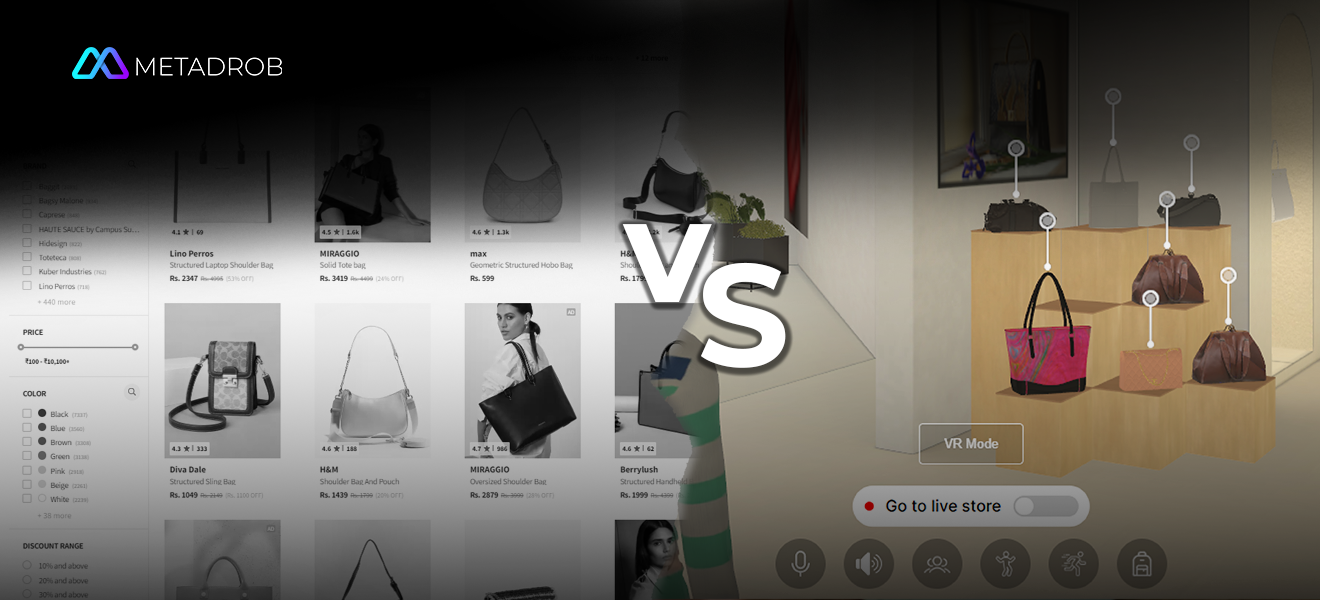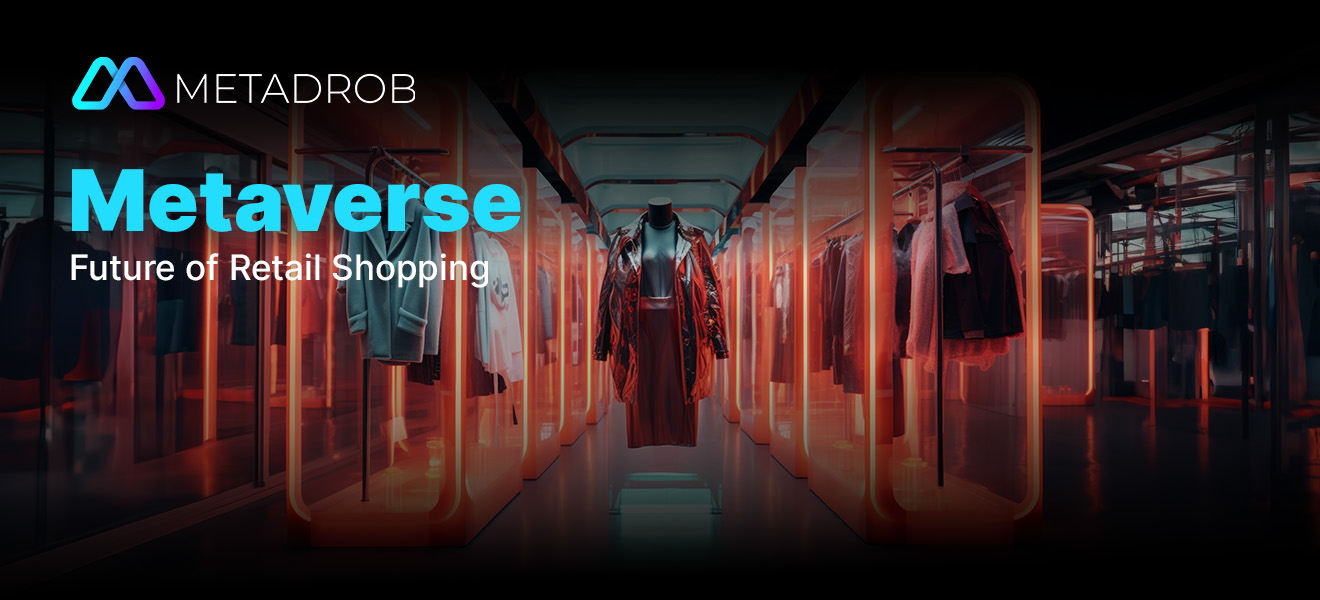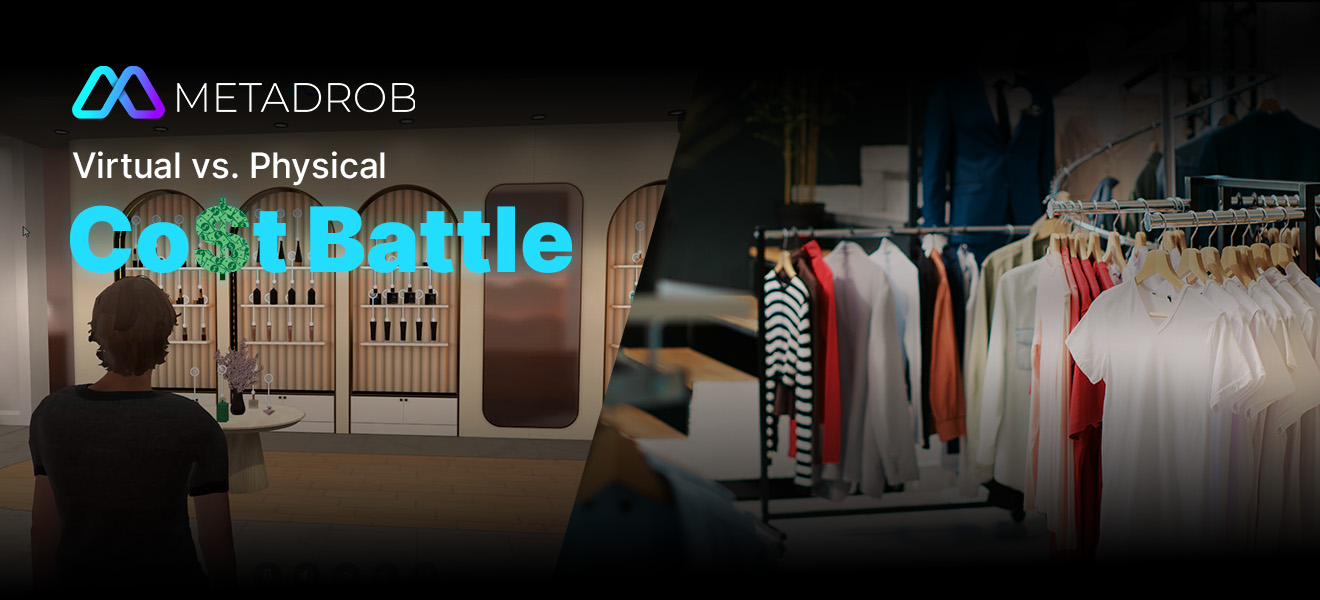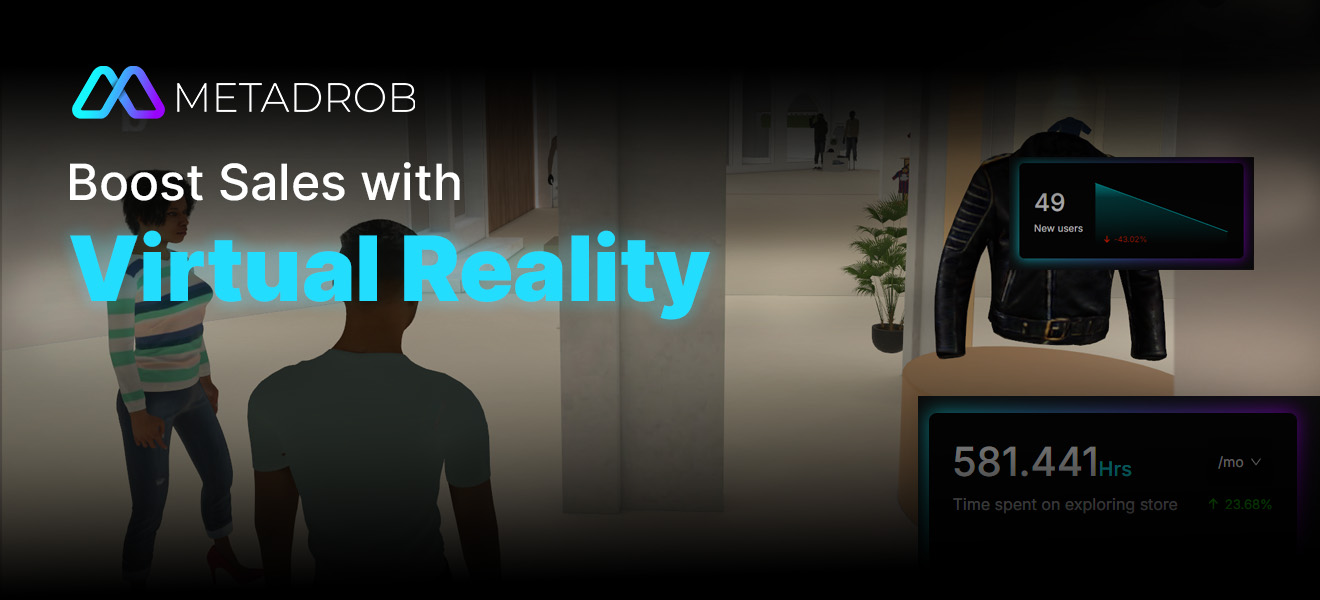Why 3D Virtual Stores Are Essential For Apparel Retailers In The Digital Age

Traditional online stores have been the pillars of e-commerce over the years, helping buyers to purchase from anywhere. They have been strategic pioneers in the retail platform by providing the best interfaces and huge product databases.
However, the rise of advanced technology that has come into the business world is the 3D virtual business. The appealing and immersive 3D virtual stores are gaining popularity very fast. Although conventional online merchants still dominate the majority, the 3D virtual environment has its attraction.
As the retail business advances, the question arises: Which one of the platforms is more suitable for shopping? As much as first-generation online retail shops are good enough in terms of convenience, 3D virtual shops are far more fascinating and mark a significant step towards innovating the business of selling products.
Understanding the Basics
The retail environment has changed significantly, and what were store-based retail outlets are now online. Now, a new frontier has emerged: 3D virtual shops. Here are the differences between the two types of shopping that define them most accurately:
- Traditional Online Stores
- Key features:
- Functionalities:
- Examples:
- 3D Virtual Stores
- Core concepts:
- Technology:
- Examples:
- User Interface and Navigation
Traditional online shops are digital versions of real ones. They provide an easy way for clients to view and buy things. Key features include:
Product listings, a shopping cart, a checkout procedure, and customer account management.
Search and filter options, product descriptions, photos, user reviews, and payment gateways.
Amazon, eBay, Walmart.com.
3D virtual stores build immersive digital worlds that allow shoppers to explore things in three dimensions. They use modern technology to create a more engaging buying experience.
This includes virtual showrooms, product visualization, interactive aspects, and virtual try-ons.
3D modeling, rendering, augmented reality (AR), and virtual reality (VR).
Nike’s virtual flagship store, Gucci Garden.
The UI and navigation system have a huge impact on the purchasing experience. Traditional online stores usually have a flat, two-dimensional structure with menus, categories, and product grids. Conversely, 3D virtual stores provide a more intuitive and dynamic user interface, allowing shoppers to navigate virtual areas and explore merchandise more engagingly.
While typical online stores prioritize product information and convenience of purchase, 3D virtual stores emphasize creating an engaging environment and giving a more realistic shopping experience.
The Shopping Experience
Traditional online stores provide a familiar digital purchasing experience. Customers can browse product categories, search for specific items, and read extensive product descriptions before purchasing. The checkout process is usually simple.
On the other hand, 3D virtual shopfronts transform the shopping experience. These immersive environments take buyers into digital showrooms where they may study things from all angles using 360-degree views and zoom features.
The ability to digitally try on apparel or see furniture in various contexts transforms product discovery and selection. Interactive components and virtual assistants improve the buying experience by making it more interesting and personalized.
While typical online businesses excel at efficiency, 3D virtual stores focus on immersion and engagement. Your ideal shopping experience and the type of products for sale ultimately determine the decision between the two.
Customer Engagement and Interaction
| Feature | Traditional Online Stores | 3D Virtual Stores |
| Customer Reviews & Ratings | Yes | Yes |
| Product Questions | Yes (limited interaction) | Live chat with experts (potential) |
| Customer Support | Email, ticketing system | Live chat, virtual assistants |
| Community Features | Limited (forum discussions) | Social spaces, interactive events |
| Social Sharing | Product sharing buttons | Integrated social media sharing, user-generated content opportunities |
While traditional stores provide basic review and support functions, 3D virtual stores offer a more interactive experience. Live chat, virtual assistants, and community features promote real-time engagement and strengthen customer connections.
Immersive Experience and Brand Building
Traditional online businesses, while handy, provide a restricted platform for brand storytelling. Their two-dimensional design limits the potential to build immersive experiences that appeal to clients. Product photos and descriptions are the major instruments, yet they frequently fail to elicit emotions or develop a strong brand identity.
On the contrary, 3D virtual shopfronts provide a breakthrough platform for brand immersion. Retailers may create fascinating storylines by methodically crafting digital places that showcase their brand’s identity and values. Interactive components, such as virtual try-ons and product demos, foster a physical relationship with customers. This level of participation promotes a better understanding of the brand, ultimately leading to customer loyalty.
While typical online shops struggle to move beyond the product-focused experience, 3D virtual stores provide a plethora of opportunities for establishing memorable and meaningful brand interactions.
Technology and Infrastructure
- Traditional Online Stores
- E-commerce platforms: For setup and maintenance, use proven platforms such as Shopify, Magento, and WooCommerce.
- Website development necessitates HTML, CSS, and JavaScript expertise for customization.
- Hosting entails selecting a reputable hosting provider to ensure website availability and performance.
- 3D Virtual Stores
- 3D modeling:
- Rendering:
- VR technology:
- Platform requirements:
- Comparison
- Costs:
- Development time:
- Maintenance:
Creates virtual environments and products using software such as Blender, Maya, and 3ds Max.
Converts 3D models into high-quality photos or films for presentation.
VR headsets may be used to provide immersive experiences.
Specific platforms (Unity, Unreal Engine) are frequently required for development and deployment.
Traditional stores are typically less expensive than 3D virtual stores, which need major expenditures in software, technology, and experience.
Traditional stores can be established fast, but 3D virtual stores require longer development cycles due to intricate design and rendering processes.
Traditional stores require regular upgrades and security precautions, while 3D virtual stores require continuous optimization for performance and user experience.
Challenges and Opportunities
The online retail world is changing rapidly. Traditional online retailers, while handy, are facing increased competition, shipping complications, and high return rates. These difficulties require new solutions. Enter 3D virtual stores, which provide immersive experiences and potentially revolutionize the business.
However, 3D virtual shop fronts are not without their challenges. Creating high-quality 3D models and providing seamless user experiences necessitates substantial technology expenditures. Additionally, protecting consumer data in a virtual environment is critical.
Despite the limitations, both approaches offer potential. Traditional retailers may use data analytics to improve operations and tailor customer experiences. Meanwhile, 3D virtual stores can strengthen brand ties, reduce returns with interactive product visualization, and potentially save operational costs. Finally, a hybrid strategy, incorporating the best of both worlds, could be the future of retail.
Which Is Ultimately Better?
The e-commerce industry is fast changing, with 3D virtual stores emerging as a possible game changer. Let us compare them to typical online stores.
- Traditional Online Stores
- Pros:
- Cons:
- 3D Virtual Stores
- Pros:
- Cons:
Convenient, wide product range, established infrastructure.
Limited product visualization, lack of immersive experience, potential for information overload.
Immersive shopping experience, enhanced product visualization (360-degree views, zoom, virtual try-ons), potential for personalized interactions (virtual assistants, live chat), stronger brand-building opportunities.
Higher development costs, potential technical limitations, reliance on advanced technology.
Traditional online shops thrive at convenience, while 3D virtual stores provide a more interesting and dynamic purchasing experience. As technology progresses, 3D virtual stores have the potential to transform retail by offering customers unrivaled product discovery and brand immersion.
The Future of Retail
This is the new world of the retail sector, where workers are more likely to gain than lose from globalization. While simple web-based retail stores have been the norm, 3D virtual stores may become prominent competition. It can be expected that the future will incorporate both models where necessary.
AR/VR is one of the technologies incorporated into the shopping experience. AR allows the buyer to view the objects in his actual environment, while VR provides shop scenery and allows the shopper to interact with the products in real-life scenarios.
Of all those, 3D virtual stores are right on the edge of this kind of development. These are the best opportunities for the brand story, consumer engagement, and data analysis. It may also be useful to create a more interesting atmosphere for such stores and suggest the products to the buyers.
As technology advances, this division between physical, online, and virtual purchasing will only become increasingly blurred; thus, we will have a complete omnichannel retailing experience.
Conclusion
Traditional online stores and 3D virtual stores provide various benefits and problems. While the former is more convenient and accessible, the latter provides an immersive, engaging experience. Traditional stores excel in product selection and speed, but virtual stores excel in product visualization and consumer engagement.
The potential for 3D virtual shopfronts to transform retail is apparent. These digital places have the potential to transform the retail experience by establishing engaging brand worlds and cultivating deeper customer interactions. As technology advances, businesses must consider incorporating 3D virtual stores into their retail operations to remain competitive and satisfy customers in this changing world.
Join The 3D Virtual Revolution & Take Your Traditional Online Store To The ‘Next Level’ With Metadrob.
Traditional online retailers, while handy, are becoming less effective at engaging customers. Enter 3D virtual stores, immersive and interactive environments that revolutionize the purchasing experience. Metadrob enables businesses to convert from flat e-commerce to visually appealing virtual showrooms smoothly.
A unique 3D store will elevate your brand, increase customer engagement, and drive sales. Metadrob lets you experience the future of retail today.
Start Your Metaverse Journey Now with Metadrob: BOOK FREE DEMO NOW!
Leave a comment
Leave a comment
Connect with Metadrob
Ready to take the first step towards unlocking opportunities, realizing goals, and embracing innovation? We're here and eager to connect.

+91 966-004-4020







Comments (32)
How Virtual Stores Boost Customer Engagement Online?,
09 September, 2024[…] compared to traditional stores, virtual stores can customize the buying experience for each individual customer because of their […]
Is Virtual Store More Cost-Effective Than a Physical Store?,
09 September, 2024[…] this article, we will explore how a robust virtual store differs from a physical store in terms of cost-effectiveness. So, let’s start and read to the […]
qbyxutrxyw,
11 November, 2024Muchas gracias. ?Como puedo iniciar sesion?
www.binance.com,
02 February, 2025Can you be more specific about the content of your article? After reading it, I still have some doubts. Hope you can help me.
binance,
02 February, 2025Thank you for your sharing. I am worried that I lack creative ideas. It is your article that makes me full of hope. Thank you. But, I have a question, can you help me?
binance,
03 March, 2025Your point of view caught my eye and was very interesting. Thanks. I have a question for you.
Compte Binance,
03 March, 2025Thank you for your sharing. I am worried that I lack creative ideas. It is your article that makes me full of hope. Thank you. But, I have a question, can you help me? https://www.binance.com/el/register?ref=IQY5TET4
registrera dig f"or binance,
03 March, 2025Thank you for your sharing. I am worried that I lack creative ideas. It is your article that makes me full of hope. Thank you. But, I have a question, can you help me? https://www.binance.com/en/register?ref=JHQQKNKN
binance "oppna konto,
03 March, 2025I don’t think the title of your article matches the content lol. Just kidding, mainly because I had some doubts after reading the article. https://www.binance.com/en-IN/register?ref=UM6SMJM3
binance,
03 March, 2025Thank you for your sharing. I am worried that I lack creative ideas. It is your article that makes me full of hope. Thank you. But, I have a question, can you help me?
binance,
03 March, 2025Can you be more specific about the content of your article? After reading it, I still have some doubts. Hope you can help me.
b^onus de registro na binance,
03 March, 2025Your article helped me a lot, is there any more related content? Thanks!
binance,
03 March, 2025I don’t think the title of your article matches the content lol. Just kidding, mainly because I had some doubts after reading the article.
binance code,
03 March, 2025I don’t think the title of your article matches the content lol. Just kidding, mainly because I had some doubts after reading the article.
www.binance.com'a kaydolun,
03 March, 2025Can you be more specific about the content of your article? After reading it, I still have some doubts. Hope you can help me.
Christel,
03 March, 2025This is tremendous important for when you’re standing, working, or leaping.
Although we can potentially alter all training variables over a training block, frequency, train selection, and loading are definitely noteworthy.
We present product evaluations and assets
about health, dietary supplements, and workouts to assist you reach your fitness life targets.
Exercise Lunatic does not provide medical recommendation, therapy, or prognosis.
The Bulgarian Weightlifting group even observed more full muscularity of their lifters who used the step-up
instead of the squat. Place one foot on prime of it after
which step ahead right into a lunge position along with
your other foot. This exercise entails attaching a rope
to a low cable pulley, standing with your again to it,
and pulling the rope via your legs whereas preserving your spine straight.
To fix inactive glutes and an absence of energy within the glute muscles, you want to focus on constructing a powerful mind-to-muscle connection. However there’s another glute muscle that’s equally as necessary referred to
as the gluteus medius. If you skip out on coaching this muscle while overtraining the glute max,
you improve your threat of muscle imbalances, strain, and lower
back pain. Based Mostly in your private responses to each of the main rep ranges, you can adjust
how a lot volume you perform in any of them.
From sprinters and cyclists to football gamers and weightlifters, highly effective
glutes contribute to improved efficiency. The fibers of the gluteus medius converge to insert on the
lateral (outside) floor of the larger trochanter of the femur.
The greater trochanter is a outstanding, bony protrusion on the upper a part of the thigh bone (femur) and serves as an attachment point for
several muscular tissues. The gluteus maximus is
the muscle that nearly everyone points to once they consider butt muscles.
Before I discuss the method to get a bigger butt,
I want to start with breaking down the muscles you’ll be focusing on. If all your pants are
saggy pants as a result of you’re missing the butt required to carry them up, it’s time to grow your glutes.
Nonetheless, the hazard is that this behavior will proceed an excessive amount of
and your body will become habituated to using completely different muscles than the ones that they should be using.
Moreover, the gluteus minimus aids in lifting your leg to the side in a movement known as hip
abduction. To feel your gluteus medius, place your palms
on your hips like you’re hanging a Superman pose.
This is an essential step no matter whether or not you desire a larger, stronger, or more sculpted butt.
The glutes have the potential to be the strongest muscles in your lower posterior chain, and this energy performs a pivotal
role in a lot of actions in daily life in addition to the fitness center.
The machine hip abduction is one other train for your smaller glute muscular tissues.
For optimal glute muscle growth, it is probably a good idea to go
deep within the leg press as properly, so prioritize depth and type over weight.
The basic barbell back squat is one of the hottest power coaching exercises on the planet and
an excellent exercise in your glutes.
The first point on loading is that the glutes, like most muscular tissues, appear to
learn from some training in all three of the rep ranges listed above.
The different 50% can perhaps be cut up evenly between the heavy
(5-10) and lightweight (20-30) rep ranges, as loading
vary range has been shown to be a potential profit in its own proper.
By incorporating these workout routines will assist you to
successfully work in the course of building stronger glutes.
Keep In Mind to regulate the weights, units,
and reps to match your health stage and progress over time.
Whereas lots of the greatest glute workout routines can be
accomplished at home utilizing just bodyweight, adding resistance bands or dumbbells is a great way
to extend the challenge and tone the glutes extra effectively.
Earlier Than adding weight to your butt exercises, try a couple of squats,
lunge variations, and/or hip thrusts to get up your sleepy glutes.
This strengthens the mind-body connection between your brain and your butt muscles
to ensure your glute max stays energetic throughout
your exercise, she says. One frequent glute activation cue is to consider squeezing your glutes
on the top of an train.
For a workout with this quantity and depth, once
a week might be about proper for many of you. Possibly repeat it one thing like each 5–7 days,
relying on your schedule and how recovered you’re, and
whenever you believe you could beat your previous
weights. If you hit three units of five reps, you improve the
burden for the following exercise and stick with that till you can as
soon as once more make 3 x 5.
Single-leg (unilateral) workout routines are significantly higher
at hitting the gluteus medius because it’s required for
stabilization. Studies have verified this, so you must at all times have some unilateral coaching in your system.
A evaluation of the best gluteus medius workouts found the Romanian deadlift to be
within the top tier for the exercises3.
Moreover, HIIT may help increase fat loss within the underbutt space whereas building power in the glutes for a more defined form.
The gluteal muscle tissue usually are not simply necessary if you
would like to fill out a pair of jeans. Your grandparents could benefit from glute strengthening exercises as they play an integral function in simple duties such as walking and even standing up.
Then, in addition they play a key position in stability which again, is
necessary for the elderly all the way down to athletes aiming to be as explosive and powerful as possible.
For athletes, the glutes are commonly seen as an important muscle group for pace.
The transfer is considered one of the very best workout routines for
focusing on this important hip muscle, per a December 2020
International Journal of Sports Activities Bodily Therapy examine.
When your knee straightens towards resistance (from gravity and the load you’re holding) your quadriceps within the front of your thighs fire.
This makes it a wonderful transfer for working and constructing the quads — and helping you more easily climb stairs.
To do an entire workout, select 4 to five of these workout routines to build a 20-minute routine.
“The important side is to verify the movement is being managed by the anterior (hind) leg and that you are decreasing yourself sufficient to really feel a deep stretch into your hamstring,” Araujo says.
Sluggish down the eccentric (lowering) part of this hip-thrust train to make it more difficult.
You can make this train more challenging by performing the bridge with one
leg off the ground.
Forward, find out whether or not strolling by itself can construct muscle, which
muscles it works, and the way to reap extra strength benefits out of your walking routine.
Out are the times of only slogging via grueling high-intensity workouts like CrossFit
and bootcamp courses day after day. Nowadays,
chiller, low-impact actions, like strolling,
are having a second, and for good reason. It doesn’t just feel
good to get your steps in—walking also has legit health benefits and might complement any exercise routine.
“You undoubtedly must stimulate the muscular tissues to assist them grow, but coaching them too much can be counterproductive when you don’t give them time to rest, restore, and rebuild,”
Vesco says. Once you turn into extra experienced with upper glute exercises, it’s completely nice to
coach back-to-back, in accordance with Dr. Reed—though, she still recommends switching it up
for essentially the most noticeable gains.
If you regularly do many of these workouts but don’t seem to be noticing
any change within the look or feel of your upper glutes, you could be participating in different behaviors that’s voiding out your hard work.
A great supplemental exercise, the donkey kick targets your butt one cheek at a time.
Maintaining this in your workout routine will assist with stability and stabilization. You’ll need a bench or
step that’s about knee degree to finish these. Nice for a warmup, the banded side step will get your hips and glutes able to go.
Increase the incline of the treadmill if your strolling apply is indoors; find hills or stairs when you’re
outside. The key to building the gluteals during treadmill walking is to slow your velocity and increase the incline
to really build power in your tush. The aim of the kidnapping work is to primarily goal the glute medius.
If you’re recovering sooner than you thought you could,
practice a bit more typically. After a mesocycle of such changes,
you’ll have a tough however superb guess as to what your average glute training frequency may be
for most of your applications going forward. You’ll
discover that relying on the exercise and on the lifter, very completely different rest times
shall be generated by this questionnaire.
And if you’re on the larger and stronger side of things, and your cardio isn’t nice,
you’ll be resting much longer than somebody smaller,
not as strong, and in glorious cardio form.
The tension must be taught when standing with toes shoulder
length apart. To full a bodyweight squat, simply stand with the ft hip-width aside and lower your physique as if sitting again right into a chair.
Strive to keep knees behind the toes and be sure to hold the weight in your heels throughout
this movement.
Then add glute isolation workout routines, like donkey kicks and supermans,
as a complement. That slight improve of range of motion can mean a larger stretch of the glutes.
So let’s have a look at my prime 6 greatest glute building workouts in detail.
In a quadruped place, lengthen one arm and the alternative leg straight out.
They interact the core, making it an effective glute exercise that
prompts many other muscle groups all through this exercise.
As Quickly As your steadiness is established, and you’re feeling comfy with the motion, strive completing a
set of 12 to fifteen reps on each leg. So, create your subsequent
glute exercise round these superior movements, or
give both of the programs offered a try. You’ll soon be on your approach to
developing the glutes you’ve all the time wanted.
Download The Gymshark Coaching App today to access tons of of free glute workouts.
Keep In Mind to try to increase the load you are using in each exercise
to ensure your continued muscle progress and power positive aspects.
Finally, for a 3rd method of working the hip extending
muscle fibers of your gluteus maximus, we’ve the Romanian deadlift.
As Quickly As again, this exercise will complement the earlier two, this time by providing
peak resistance in yet another angle and muscle size.
In this part, we’ll check out five of one of the best glute exercises that complement each other in phrases of which
glute muscular tissues, and likewise which part of the glute muscle
tissue, they aim. Deadlifts are great in your glutes,
hamstrings, and lower again, but this one-legged version is an especially good butt workout.
Our muscles are like chains, and when one is weak or messes up, a response happens that ends up with the opposite muscle tissue and joints overcompensating or being instantly injured.
But if you’ve been training consistently and don’t
feel as though your glutes have anything to level out for it, it may not
be your butt that is responsible. “And it is this muscle that’s actually doing a significant element of that.”
This exercise not only challenges your outer thighs and
gluteus medius, but also your core stability muscles to assist improve your balance.
When you get comfy with a Romanian deadlift, you can begin doing single-leg RDLs for an even tougher
gluteus maximus exercise, Katie says. But first, ensure you
can do the basic motion with excellent type.
As the name suggests, the gluteus minimus is the smallest gluteal muscle
tissue. It Is a deep muscle under the opposite gluteal muscular tissues and tensor fascia
latae that begins on the ilium (hip bone) and travels to the femur.
The gluteus minimus is similar to the gluteus medius in construction and
function.
As you would possibly imagine, this could create a complete host of issues similar
to iliotibial (IT) band syndrome, low again pain,
and knee accidents to call a number of. While aesthetics are important (and likely one of many main causes you’re
employed out), there are some muscular tissues in your body that can do rather more than simply make you
look good. The booty can’t grow if you’re not consuming the proper meals to develop glutes.
With a name like minimus, you would most likely guess that
it’s the smallest of the three muscles. In actuality, the gluteus
minimus is sort of just like a smaller gluteus medius.
Its insertions and origins are the identical, and it sits directly underneath the gluteus medius.
It additionally aids in hip exterior rotation i.e. pointing the
toes outwards. The underbutt, because the name suggests, is
that space beneath your butt where your glutes
meet your hamstrings, typically known as the glute-ham tie-in. To target the underbutt, we must be wanting
within the path of the decrease glutes and the hamstrings.
Building the glutes, together with the underbutt is a objective high on the agenda for many health club goers.
Get your resistance band ready–these lateral band walks (AKA crab walks) could have your higher glutes on 🔥.
This abduction high glute exercise makes your glutes work
towards the band to manage the movement and maintain your knees driving out.
Analysis has found this one of the effective useful
workouts in activating the glute medius [2]. We’ve
received body weight and banded choices that can be accomplished from house, along with weighted variations to increase the depth of your glute workout.
The banded upper glute exercises also work properly
as a half of a warm-up to activate the higher glutes to ensure you engage
them throughout your compound leg workouts. Week to week, you presumably can manipulate working
units by utilizing the Set Development algorithm from
the Training Volume Landmarks for Muscle Growth
(link) article. The means you retain the reps secure as RIR falls is by including
weight to the workouts you’re utilizing.
my blog :: Muscle Build Steroids
бнанс акаунт,
03 March, 2025Thanks for sharing. I read many of your blog posts, cool, your blog is very good.
binance registrering,
03 March, 2025Thank you for your sharing. I am worried that I lack creative ideas. It is your article that makes me full of hope. Thank you. But, I have a question, can you help me?
Anonymous,
03 March, 2025Your article helped me a lot, is there any more related content? Thanks!
binance,
03 March, 2025Your point of view caught my eye and was very interesting. Thanks. I have a question for you. https://accounts.binance.com/en-ZA/register-person?ref=JHQQKNKN
Μπνου εγγραφ Binance,
03 March, 2025Your point of view caught my eye and was very interesting. Thanks. I have a question for you.
Esperanza,
03 March, 2025Bifidobacterium Bifidum is doubtless one of the most plentiful probiotics present in your digestive
system, so it makes sense it’s used in AG1 powders.
It’s handy and mixes properly with smoothies and contains a
full vary of various kinds of greens. Great for these trying to up their wellness game, improve their vitality, and reside a
more vibrant life, it’s reasonably priced and simple to include into
your day.
This complement accommodates varied superfoods, herbs, and grasses that
may assist boost total well being. For these on the lookout for a cheaper alternative, Superb
Grass Greens Blend Superfood is a compelling possibility.
It presents a similar high quality to Athletic Greens with out sacrificing quality.
This green powder is composed of varied important superfood components
that may assist boost health and vitality. While Athletic Greens is on the pricier aspect of
the greens complement market, it’s important to consider the worth it provides.
Vibrant Well Being was based by vitamin scientist Mark
Timon in 1992 in Great Valley, New York, as a method for people to achieve optimal health through whole-food nutrition, herbs, and pure extracts.
Digestion – 25 billion CFUs of probiotics, prebiotics, enzymes, and dietary fiber help normal, healthy digestion, alleviate GI discomfort, and assist curb appetite.
All The Time consult with a professional healthcare professional prior
to beginning any diet or exercise program or taking any dietary complement.
AG1 powders additionally use adaptogens, which help you management stress simpler.
Two of the most prevalent elements in AG1 supplements that include adaptogens are eleuthero root
and Rhodiola.
With seventy five totally different useful components, AG1 is like combining 5 supplements in a single to assist profit
your power, immune system, digestion, mind, and metabolism.
While different greens powders have usually
been dismissed as a result of their historically earthy flavors,
some products are altering the narrative. As talked about
above, even though Organifi has numerous quality superfoods, I’m not confident in its ability to assist immunity with out more information about its nutritional vitamins and
minerals. AG1 is designed specifically for athletes,
whereas Stay it Up Super Greens is formulated to cater to the dietary needs of the average
particular person seeking a every day boost.
This article will dig into the nitty-gritty details of both Athletic Greens and Stay it Up
Super Greens that will assist you resolve which greens powder is the only option for you.
Some ingredients may be contraindicated for sure individuals, adaptogens may intrude
with sure medications. Ingredient ashwagandha is advised not
to be used during being pregnant or breastfeeding, this is said in the website’s FAQs ought to – if – they be learn. Created by My
Greens Day By Day Mygreensdaily does not provide medical advice,
diagnosis or remedy. Rhodiola Rosea root Extract –
This root powder extract is essential for increasing virility and stamina,
lowering stress and boosting anti-fatigue. The manufacturer of Athletic Greens products has saved the efficiency greater that gives
good results in low dosage.
I additionally actually favored that my mood felt more secure and overall extra
nice due to the mix of adaptogens in the greens mix.
Gundry MD Primal Vegetation is a superfood method with
25 components to boost total wellness. It contains greens, probiotics, herbs, and
enzymes, amongst other elements. You could know that fruit and
veggies have lots of nutritional vitamins and
minerals. However additionally they comprise what are generally recognized
as “phytonutrients”, that are plant compounds that
profit human well being.
Different key potential advantages this greens powder is acknowledged to support include sustaining a healthy weight,
aiding longevity, and offering nutrient density for essential nourishment.
Intestine well being is a hot subject right now,
and many of us suffer from bloating discomfort, gasoline, and other digestive woes.
This greens powder accommodates dairy-free probiotics,
coming in at 5 billion CFUs, as well as three plant-based digestive
enzymes. Along with providing important blends of nutritional vitamins, minerals,
probiotics, and digestive enzymes – it additionally hosts some mind nootropic herbs that assist in improving cognitive and mind efficiency.
Athletic Greens is a greens powder that accommodates a powerful variety of nutritional vitamins, minerals, and different
nutrients.
Reside it Up Tremendous Greens costs just $39.99 ($1.33 per serving) with a monthly subscription. And whereas we don’t know
the exact ingredient quantities since this product has proprietary
blends, we will inform a minimal of that the Tremendous Mushroom Advanced misses the mark for dosing.
It packs in 5 ingredients in simply 154mg, and the vast
majority of these ingredients are most effective when dosed at a minimal of several grams every.
Based on the ingredient profile, Athletic Greens provides several advantages, as
claimed by the producer. These embrace assist for the immune system, overall
health optimization, improved nutrition, and enhanced digestive
health. It’s important to note that the proof supporting these advantages
is derived from the ingredient composition. If you’ve ever
peeked into the world of superfood powder drinks,
you’ve probably noticed Athletic Greens.
It stands proper there amongst some other massive names
in the marketplace, delivering benefits you can probably
get at a fraction of the worth. The first thing our
research staff did was to research the ingredients and
potential unwanted effects. The company makes claims, so we reviewed the research linked to the elements.
AG1 is an easy, drinkable day by day supplement that supports brain,
immune, and digestive well being by way of a science-driven method of vitamins, minerals,
good micro organism, and whole food sourced elements.
One day by day serving of AG1 can eliminate the need for many other dietary supplements such as
many multivitamins and multiminerals, good micro organism, greens and superfood powders, vitamin B complexes and vitamin C tablets.
It helps digestion, which means it could additionally substitute different digestive aids.
Athletic greens comes in scorching with an astounding forty five superfood ingredients.
References:
safe legal steroids (https://vads.in/index.php?page=user&action=pub_profile&id=8060)
Hung,
03 March, 2025The greatest barbell again workout routines are people who
promote useful strength across several muscle teams and successfully develop your again.
The 4 greatest reverse fly variations for constructing higher back muscles are as follows.
It’s generally secure to perform reverse
flies if you keep the proper kind. Nevertheless, the train might exacerbate existing musculoskeletal accidents, so talk about your planned workout routine with a physician in case you
have an injured joint, bone, or muscle. Usually speaking, coaching your again 2-3
instances a week yields the most effective results.
Nicely, as a end result of that is considered one of its main movement capabilities, and
is something that our earlier rear delt exercise was lacking.
To progress this over time, simply deliver your
ft closer to the door just as we did within the final
exercise.
Higher recovery between exercises – improving blood circulate to your working muscles might speed up recovery from set to set.
As such, you may have the ability to do more reps or use heavier weights for agonist/antagonist supersets compared to typical or
straight units. The rotator cuff is the collective name for the four small muscular tissues that
management and stabilize your shoulder joint.
The rotator cuff muscle tissue are the supraspinatus, infraspinatus, teres minor,
and subscapularis. While you can’t see your rotator cuff,
they are important for the protected and effective performance of all chest and back exercises.
I now build all my exercises around supersets, so I’m both
in and out of the fitness center in minutes as an alternative of hours or cramming extra training
quantity into less time. I not often do regular
sets, and when I do, I often get impatient throughout the remaining intervals.
For lifters who are intermediate-advanced or advanced, following a program for 4-6 weeks is usually an excellent time frame.
It’s a powerful transfer that uses explosiveness to propel the
load upward, which ought to permit roughly 30% extra weight than a regular
shoulder press. Now let us take a glance at one of the best shoulder workouts and tips on how to carry out them correctly.
For the opposite muscle, use larger reps so you’re fatiguing your muscle tissue with out cutting into your restoration. You can alternate between again and shoulder strength and measurement
for the most effective of each weight-lifting worlds. The excessive machine row lies between the barbell bent-over row and the pull-up, activating the lats, teres main, traps, rhomboids, and biceps.
The finest shoulder exercise for preventing shoulder injuries is the Overhead Band Press
which is a shoulder activation exercise. This prepares the shoulder muscles to
work together properly and must be carried out earlier
than starting the remainder of your shoulder exercise. Push ups
may help construct shoulders, but not as well as workouts like the Barbell Overhead Press which specifically targets the shoulders and may be overloaded with heavy weights.
Be certain to incorporate the Barbell Overhead Press in your shoulder programming.
Incorporate this into your devoted shoulder exercise routine
and you’ll see how lighter weights may help you construct greater shoulders!
For a extra in depth take a glance at this technique and a step-by-step breakdown of each of the
repetitions, try my article on The Method To Get Greater Shoulders.
The uniqueness of his routine is that he starts his training with lateral
delt and ends his exercise with the overhead press.
If you’re a bodybuilder, the significance of well-developed shoulder muscle tissue
can’t be overstated. Large delts give your higher physique
a 3D look that stands out on a bodybuilding stage, within the fitness center, or on the
seaside. Regardless of what body part you could view as a “downside space” – a time period
I would not mind seeing dying off, by the finest way – your whole physique needs smart motion.
This exercise includes lying face down on an incline bench to assist the chest.
This train can work well with a medium to light-weight for larger reps.
It can also be well-liked amongst athletes and strength trainers
for its ability to develop explosive power, coordination, and strength.
It develops explosive power within the legs, hips, and shoulders.
The Barbell Z Press is a challenging and effective shoulder exercise that
strongman Zydrunas Savickas popularized, hence the name “Z Press. It is an effective and efficient approach to obtain a full-body workout in a short period of time. When starting with shoulder training, phrases like “Landmine Press” and “Dumbbell Clear and Press” can get somewhat overwhelming.
References:
all natural Steroids (wacari-git.ru)
Julie,
03 March, 202570918248
References:
Can steroids Be used safely
Julie,
03 March, 202570918248
References:
Can steroids Be used safely
Ursula,
03 March, 202570918248
References:
legal steroids weight loss, media.motorsync.co.uk,
Ursula,
03 March, 202570918248
References:
legal steroids weight loss, media.motorsync.co.uk,
Ursula,
03 March, 202570918248
References:
legal steroids weight loss, media.motorsync.co.uk,
Christie,
03 March, 202570918248
References:
steroids and hgh – http://www.myjobsghana.com –
Jennifer,
03 March, 202570918248
References:
safest steroids to take; Julienne,
Thorsten,
03 March, 202570918248
References:
is steroids legal
binance konto skapande,
04 April, 2025Thanks for sharing. I read many of your blog posts, cool, your blog is very good.